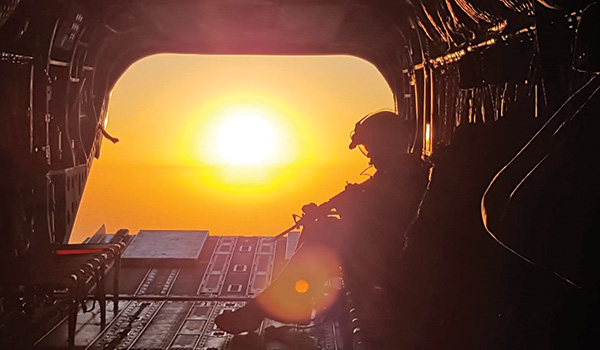
DAMO-AV / By SGM G. Mike Dove: Greetings from the Aviation Directorate at the Pentagon. As one of the newest members of the team here at Department of the Army, Military Operations – Aviation (HQDA G-3/5/7, DAMO-AV), I am extremely honored and humbled to be a part of this team of Warrior Leaders.
ø

On Veteran’s Day, November 11th, 2016, SGT Alex A. Caudle, a CH-47F crew chief assigned to Bravo Company, 5-159th General Support Aviation Battalion (GSAB) of the Virginia Reserves, relaxes after a long mission in vicinity of Kandahar with his weapon in hand, scanning out of the ramp as the desert sun sets. / U.S. ARMY PHOTO BY SSG LARRY BOTKINS
This is an exciting time for Army Aviation. With the Army’s recent increase in personnel authorization to 1.018 million the Aviation Enterprise is currently rebuilding an eleventh combat aviation brigade in Korea and the 166th Training Brigade at Fort Hood, Texas. Although increases such as these are welcome, this also increases requirements in many areas. Readiness, synchronization and communication are key areas of interest and the Army’s priority.
Readiness is developed through multiple components (man, train, equip, and leader development) which require persistent synchronization. Readiness remains the Army’s number one priority. Aviation readiness is not specific to individual Soldiers, it must also include the readiness of the equipment and unit processes. Manned and Unmanned aircraft must be maintained at the highest state of operational readiness. This requires application of all the components of readiness listed above. Additionally, as stated in TC 3.04-11, aviation maintenance requires the constant involvement of commanders and leaders at every level. The Forces Command Monthly Aviation Readiness Review is one such example of leaders at every level taking a vested interest in aviation maintenance communication, synchronization and readiness as a whole.
Within the DAMO-AV, we synchronize efforts on aviation related programs, projects, and initiatives throughout the Department of the Army Headquarters. Every day we work with directorates within the G-1, G-4, G-8, training, and force management to name a few. Additionally, we coordinate with Aviation and Missile Command, Training and Doctrine Command, the Aviation Center of Excellence (AvCOE), and industry partners. All of which is in support of combatant commanders, the Army Commands, Army Service Component Commands and Direct Reporting Units. These commands, directorates, and industry partners are the main elements of the Aviation Enterprise.
In order to synchronize all of our efforts across the Aviation Enterprise, we must communicate effectively and efficiently. Any and all new ideas, current programs of record and future projects must be communicated and synchronized up and down their respective chains of command or authorities.
As leaders of complex, multi-component organizations, the three competencies of readiness, synchronization, and communication are essential elements of daily operations. This is a complex world with state and non-state actors, operations spanning the globe and combat operations ongoing in regions identical or similar to those of the past two decades. It is imperative that we forge relationships across all components of the Army and continue to build on those relationships as we move throughout the enterprise and across our military careers. The demands of our Army and our nation rely on such cooperation, communication, synchronization and readiness.
I look forward to working with the outstanding team we have within the directorate, the outstanding Soldiers, and civilians from across the Aviation Enterprise and our Army.
Above The Best!
SGM Mike Dove
SGM G. Mike Dove is the sergeant major of the Aviation Directorate of the Office of the Deputy Chief of Staff G-3/5/7 of the U.S. Army in Washington, DC.








